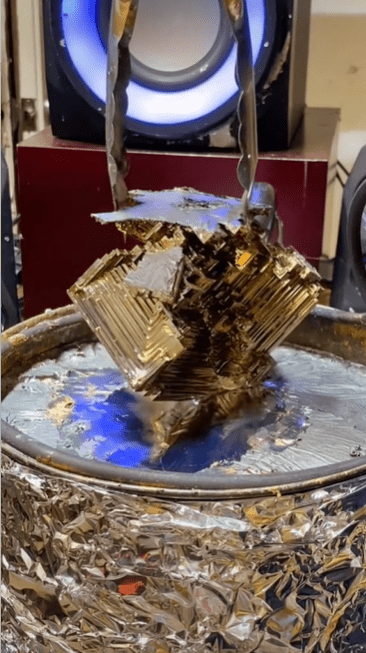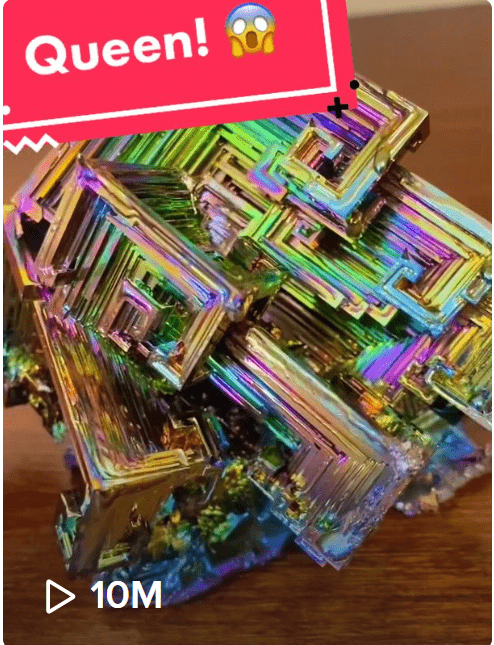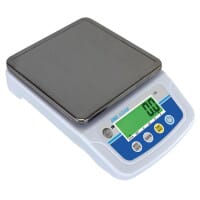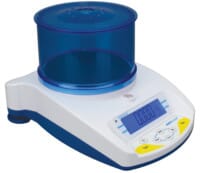

“If you love watching the art of nature and the beauty of science come together, you’re definitely going to want to stick around” – Jonathan Henrikson
Love it or hate it, social media has become a goldmine – or in this case, a crystal mine – of information, inspiration, and innovation. Somehow, TikTok creator Jonathan Henrikson (@Minerals_Rock) has managed to find a unique way to combine all three with his content. This blog will discuss Henrikson’s crystal bismuth business, his creative process, as well as how scales like our compact balances have an impact.
An avid rock and mineral lover, Illinois native Henrikson has been posting videos detailing the process of creating bismuth crystals to a rapidly growing audience for over a year now. Thanks to his own determination as well as his helpful and engaged viewers, Henrikson has been able to develop and improve his technique, and even add a fun spin – music.

What is Bismuth?
Bismuth is a particularly heavy, brittle metal that is slightly (harmlessly) radioactive and has a low melting point. It’s one of the active ingredients in pharmaceutical medicines such as bismuth subsalicylate, better known as Pepto Bismol, and certain pigmented cosmetics. However, bismuth is not just a remedy for an upset stomach, it also makes for a charming decoration.
While naturally silver, bismuth turns vivid rainbow colors when oxidized with heat and allowed to cool. Under the right conditions, this metal forms fascinating geometric patterns, or “crystals,” that typically resemble a series of stacking staircases. All bismuth crystals are man-made and one-of-a-kind, so how does Henrikson do it?
The Creative Process
Because bismuth has such a low melting point, it can be easily liquified by heating it in a pot over a regular kitchen stove at 520 degrees Fahrenheit. Within the pot, science is working its magic. Essentially, by heating the bismuth to a liquid and allowing it to cool for the right amount of time, the bismuth undergoes a molecular process that allows it to form its beautiful colors and patterns.
At the beginning of his crystal-growing journey, Henrikson would heat the bismuth only on the bottom and then allow it to cool in an insulated bucket. Once he felt it was ready, Henrikson would pour out the excess liquid into a separate pot to reuse later. The bottom of the original pot would be covered in a layer of crystals, which, due to bismuth’s brittle nature, could be easily broken off into separate small, beautiful chunks.

After “hundreds of hours” of practice and learning how to adjust for unexpected challenges such as weather interference, Henrikson has improved his technique and knowledge. Now, he adds a heated coil to the top of the pot, which helps keep a consistent temperature throughout and prevents the bismuth from accumulating and forming a layer at the bottom.
“With my method, the metal cools in the middle first, which seeds the metal to crystallize from that point, and I pull the crystal out at whatever point in the growing process I want to,” Henrikson explains.
With a pair of tongs, Henrikson gently reaches into the pot and extracts the crystal that’s formed in the center – with much larger and more intricate results than when he first began learning.

Music to His Ears
Henrikson has over 1 million followers on TikTok, many of whom provide helpful suggestions on techniques to try, such as tossing in a magnet – bismuth is repulsed by magnets, AKA diamagnetic - adding in other metals for the crystals to attach to, and even running an electric current through the metal. Each of these techniques makes unique crystals, but one approach stuck the best: playing music.
Henrikson started off strong by playing Beyonce’s songs during the heating and cooling process, letting the vibrations and sound waves influence the structure of the crystals.

Henrikson explains, “The sound waves essentially just are traveling through the molten metal as it is cooling and crystallizing … instead of the molecules coming together naturally in their own way they are hit with the sound waves and moved around a bit before settling down.”
Suddenly, there were thousands of song and artist requests from followers, from Queen to the Beatles to Taylor Swift. Each musical artist produces unique crystalline structures.
Where Do Scales Come into the Process?
In order to make bismuth crystals, Henrikson starts out by purchasing bismuth ingots. Businesses that sell ingots of bismuth do so by selling boxes of a particular number of pounds, made possible by utilizing a high-capacity floor or bench scale, both for packing and shipping.
Companies that price their bismuth based on weight are legally required to use a trade-approved scale to weigh and price the ingots. This helps guarantee that each customer is getting what they paid for, no more and no less.
On Henrikson’s part, he uses a scale to weigh his creations to show off how “surprisingly heavy” each crystal is, as bismuth is “slightly heavier than lead.” This also helps to set his viewer’s expectations on the approximate weight and size they would be receiving should they decide to purchase a particular crystal on Henrikson’s Etsy shop MineralsRockTikTok.
Though the weight of the crystal isn’t displayed on his Etsy shop, it does have an influence on the prices of his crystals, as well as the size and the “quality of the structure, including the overall appeal of the piece.” Shipping costs are also determined by the weight of each piece, “as per standard shipping practice.” For all of these purposes, a Highland portable precision balance or a CBX compact balance is perfect.
We would like to thank Jonathan Henrikson for providing us with an interview, for the images used in this blog, and for inspiring a deep dive into the wonderful ways scales and balances can be used throughout the world!



